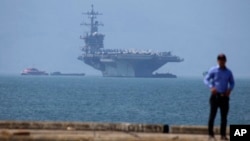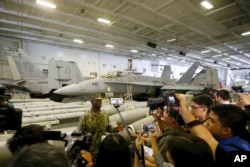Plans for a first-ever joint military exercise by China and Southeast Asian nations this year would calm safety risks on the most heavily contested sea in Asia and could ease fear of Beijing’s dominant role in the sovereignty dispute.
At a meeting in February, defense ministers from the 10-member Association of Southeast Asian Nations (ASEAN) “welcomed” the prospect of a maritime exercise with China by the end of 2018, Singapore’s defense ministry said in a statement. Singapore is heading the association this year. The ministers “informally” met Chinese defense minister Chang Wanquan, as well, the statement said.
Beijing claims about 90 percent of the disputed waterway, the South China Sea. In Southeast Asia, Brunei, Malaysia, the Philippines and Vietnam also claim swathes of the sea, vying with China’s holdings. Taiwan calls the whole sea its own, as well. China, which has the world’s third most powerful armed forces, has irked the others since 2010 by landfilling islets for military use.
Odds of an exercise this year are high, said Fabrizio Bozzato, a Taiwan Strategy Research Association fellow specializing in East Asia.
“This time China is moving to engage ASEAN at a multilateral and collective level for the sake of winning their trust, soothing fears of China’s overwhelming military supremacy by boosting collective self-confidence and enhancing the role of ASEAN as the preferred interface and dialogue platform,” he said.
Reducing risk of conflict
Clashes in the South China Sea are rare, as the rival countries are used to watching out for one another, scholars say. But sailors died in Sino-Vietnamese clashes at sea 1974 and 1988. In 2014, boats from China and Vietnam rammed each other after China let its chief offshore driller place on oil rig in the sea.
Cooling risk of a new conflict led the China-ASEAN political agenda last year when heads of state agreed to work out a South China Sea code of conduct. The code, an extension of a declaration signed in 2002, would spell out ways to prevent accidents at sea. The parties aim to sign it this year.
A joint maritime exercise would back up the code of conduct, Bozzato said.
The countries would send their best military officers to the exercise and simulate a conflict scene on the 3.5 million-square-kilometer sea that extends from Borneo to Hong Kong, analysts believe.
Philippine Defense Secretary Delfin Lorenzana suggested this month the exercises might start with a “table top” phase, a term that usually means simulating emergencies without sending ships to sea.
Exercises should let the different countries exchange skills in fighting fires and rescuing people after boat collisions, said Carl Thayer, Southeast Asia-specialized emeritus professor with the University of New South Wales in Australia.
The exercises would form bonds among military officials, who might encounter one another again during a future clash at sea and be able to work things out fast, he said.
“Theoretically, in a crisis or unexpected situation you have that kind of trust already, that people do know who they’re dealing with, so that’s always seen as an important part militarily and ships even more so because they’re isolated rather than units on the ground,” Thayer said.
Advantage for China
China has jumped in to make the others more confident and protect its own vessels, Thayer said. It sees the exercises as an “early harvest” of longer-term cooperation with the ASEAN bloc, he said.
Southeast Asian countries, if instead pressured by China at sea, can turn to the United States for support. Washington does not claim the sea but periodically sends naval vessels to back its position that it should be open for freedom of navigation.
China often fumes when the United States, which is militarily stronger than China, sends ships. This month the USS Carl Vinson aircraft carrier group reached the Philippines and Vietnam, putting China on alert.
“On its own, a joint exercise among claimants in disputed waters would mark an important development in regional relations,” said Jonathan Spangler, director of the South China Sea Think Tank in Taipei.
But improvement of broader relations would take longer, he said. "It all depends whether or not China and ASEAN can keep up the positive momentum," Spangler said. "Because the underlying disputes have not been resolved yet, that may prove difficult in the long run.”
Questions about location
Southeast Asian leaders still must pick locations for any exercises, a possible sticking point. Countries that claim sovereignty over the spot would need to sign off, and no one has formally offered.
The first exercise, if not a table-top phase, might take place outside the South China Sea but close enough to simulate it, analysts say.
“Because it’s a confidence-building exercise, it certainly has the South China Sea in mind, and because it has the South China Sea in mind there are also political sensitivities as to what will be the scope of the exercise,” said Collin Koh, maritime security research fellow at Nanyang Technological University in Singapore. The parties will probably avoid war simulation, he added.
“We’re not going to expect something that is kinetic in nature,” Koh said. “I don’t think we’re expecting something that involves live firing or the use of conventional weapons systems.”














